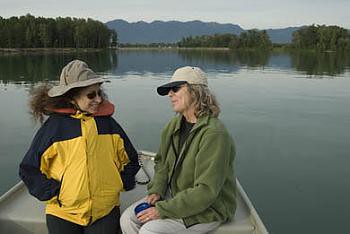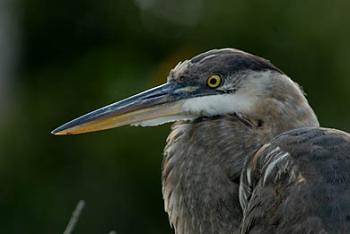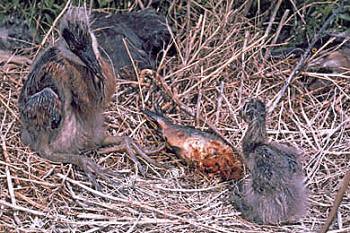A New Great Blue Heron Rookery

Janie and Marie floating on the Flathead
©Bert Gildart: Just about this same time last summer, Janie and I took our friends Rich Luhr (owner/editor Airstream Life Magazine) and family in our boat up the Flathead River, searching in part for a huge rookery of Great Blue Herons. Though we searched and searched, we could not find a sign of this magnificent bird or the rookeries that once existed.
Last week, I am delighted to report that while repeating the explorations–but this time with our Ohio-based friends Brian Maughn and Marie Hertzler-Maughn–we discovered a brand new heron rookery. The rookery was huge, spread out over five to six large cottonwood trees all tightly grouped. In them were about 20 to 25 nests, and we could hear the ratcheting noise the group made over the sounds produced by our Yamaha engine. Quiet though our four-stroke may be, we were sitting next to it, so the croaking of the 40 to 50 herons had to be loud, because that’s what first drew our attention to them.
Over the years, I’ve written about the bird and here are a few paragraphs from previous magazines publications.

Great Blue Heron
Almost every outdoorsman knows him—the great blue heron, one of the largest and most common of our wading birds. “Old Spearhead” is the one that startles you with a hoarse quock, as he heaves majestically out of the reeds, tucks back his dangling gear, and chugs away with slow and methodical wing beats.
In the hinterlands he is sometimes known as a “crane,” which he most certainly isn’t, and the difference is plain enough. A crane flies with neck extended, whereas, the heron loops his neck into a compact S and carries his head snugly back on his shoulders. The silhouette is unmistakable whether you see him half a mile above the business district or skimming down the Flathead River.
Generally gray-blue above, and streaked whitish and black on the breast, the bird has a conspicuous black-and chestnut crescent at the angle of the wing. The head is outlined by a drooping black crest with a topping of white. The bill is deep yellow and the legs and feet (which trail like a rudder in flight) are black.

Stilletto beak great for catching dinner
By the time the great blue heron is about two years old and ready to breed for the first time, it is respectably plumed on the back and breast. However, it doesn’t match the elaborate finery of its southern relatives, the snowy and American egrets.
If you watch the great blue stalking with deliberate, time-lapse movements in the shallows, you don’t wonder for very long what he eats. Zeroing in on something in the water, the long neck unlimbers, the head flashes down, and up he comes with a squirming fish impaled on the tip of its beak.
Occasionally a heron will tackle something too large, then the bird is in trouble. Naturalist John James Audubon told of watching a heron that had struck a fish too big to handle. The heron was pulled several yards completely under water before it was able to extricate itself.
Countrywide, great blue herons nest in a variety of different sites, but nearly always in rookeries numbering a few to several dozen nests. The usual location of such rookeries is in the tops of tall trees in a swamp or bottomland.
Heron rookeries hold a fascination for many people and I am no exception. On several occasions I have spent the entire day in a blind photographing and watching the clamor of the young as an adult arrives with a gullet full of fish.

Heron Young squablling
With a yacking and clattering the young shove one another aside in their attempts to be first at the bread line. In austere times, invariably one of the homely gray-and-white chicks dies—bested by its more competitive sibling.
In spite of the disappearance of big timber in swamps and lowlands, the great blue seems to be surviving fairly well. Irresponsible shooting is probably one of the biggest drains on its numbers. Natural enemies are not very important because the bird is hard to approach, and the efficiency of that up-front spear is not to be taken lightly by predators.
Although a strong flier, the heron is a transport type and can’t maneuver easily. Such small fry as red-wing black-birds and sparrow hawks can rattle a heron so thoroughly that it may go crashing onto the water. Though not well designed for it, the great blue can swim and take off from water.
In terms of the fish it takes, or any aspect of its feeding habits, the heron is not to be considered as either “beneficial” or “harmful.” People enjoy seeing this great wading bird. It belongs to our American waterscapes, and that is reason enough for his being…


July 7th, 2007 at 6:41 pm
Great Blue Herons are such magnificent birds. To be able to see a rookery must be a fantastic feeling!
July 28th, 2007 at 2:54 pm
I remember watching the great blue heron catch his fish in the pond by the laundry room at Bay Bayou Rv Resort last spring. It had its eye on that fish for a long time and when the time was right it made a guick move and got its lunch. They really are remarkable, graceful, and tricky.
July 25th, 2017 at 9:37 am
We have witnessed this rookery a couple of times now – amazing to watch and observe!